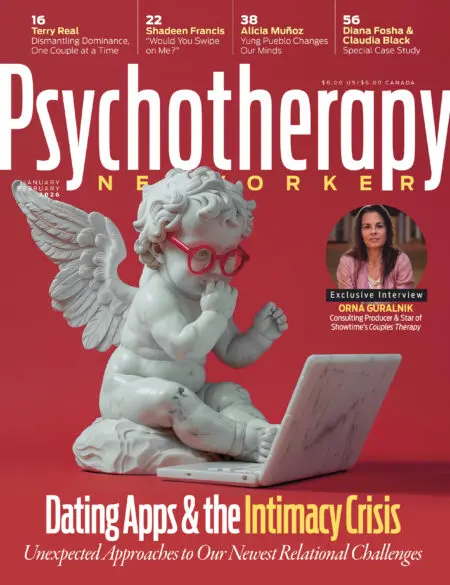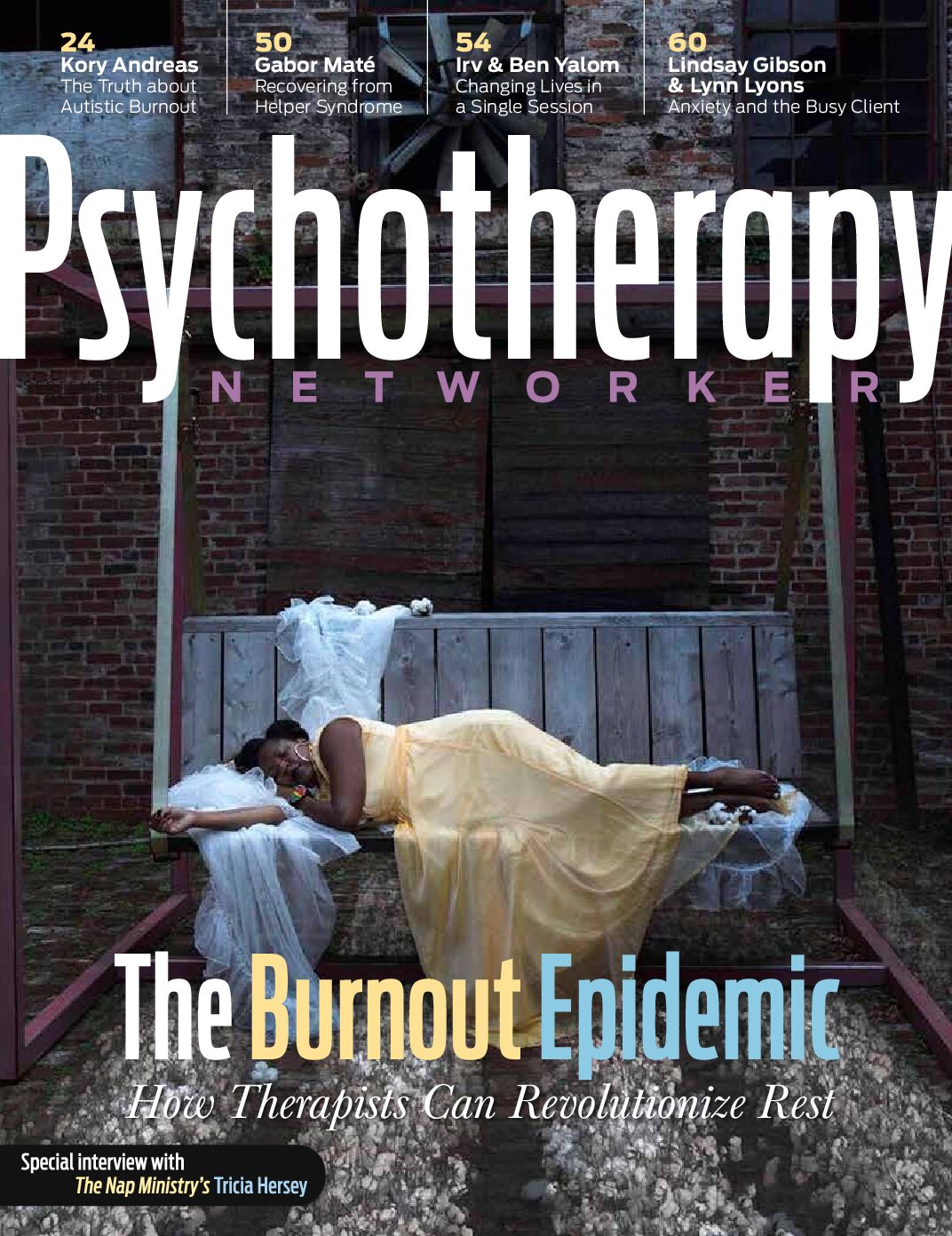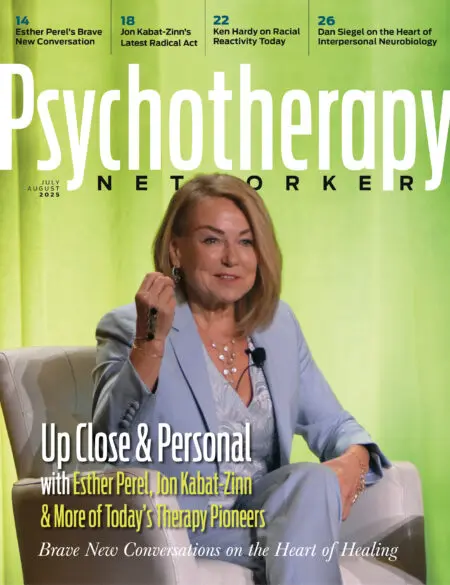Enjoy the audio version of this article—perfect for listening on the go.
How do you work with a client who’s thriving in their career and relationships, but can’t seem to make sense of their overwhelming sadness for a beloved, deceased pet? Megan Devine, world-renowned grief expert, and Leanne Campbell, internationally acclaimed EFT trainer, walk us through their different approaches to this clinical challenge.
Meet Marcus
Marcus is a successful 40-year-old lawyer who works for a Fortune 500 company. In therapy, he tells you he feels fulfilled in and outside of work. He has a loving wife, a baby girl on the way, and a handful of close friends from the local kickball team he joined last summer. Lately, you’ve been helping him find ways to manage his worries about fatherhood, especially given his rocky relationship with his emotionally distant and alcoholic father.
But in your last session, Marcus returned to discussing the event that brought him to therapy one month ago: the death of his pet cat, Snickerdoodle. You’d helped him process his initial grief, and by session four, he said he was ready to focus on other issues. But in your last session, Marcus broke down sobbing. “I can’t believe she’s gone,” he said. “Snickerdoodle was there for me through so many milestones: the law school years, new jobs, a bad breakup, and meeting my wife. I know she lived a long, happy life. I’m just having trouble with this new normal. She was like family, you know?”
Marcus has tried a variety of grounding exercises on his own to help him deal with his grief, like deep breathing and body scans. He’s also been journaling, and recently put together a scrapbook of his favorite photos of Snickerdoodle to keep as a memento. “These things help,” he tells you, “but when I think about the good times with Snick, I inevitably get a sinking feeling in my stomach, my heart races, and then I fall apart.”
“I know this must sound so stupid,” he says. “I know it’s ‘just a cat.’ But she was my cat. I just feel so alone right now.”
An Experience to Be Tended
By Megan Devine
My role as a therapist is to hold the full expression of my clients’ grief, while balancing the need for both validation and action. Marcus came to therapy to address what he felt would be a simple cure for his grief, with tools that would help him focus on the good things unfolding in his life. His returning emotions, or rather, his confusion about his returning emotions, highlight a common misconception about grief: it’s not over in a few short weeks. Although we’d discussed the realities of grief outside of what media and self-help books often describe, Marcus appears to hold himself to the ideal of “getting over his grief,” and doing it quickly.
Our culture sees grief as a kind of malady, a terrifying, messy emotion that needs to be cleaned up and put behind us as soon as possible. As a result, we have outdated beliefs around how long grief should last and what it should look like. Books, movies, and even articles on the psychology of grief often present grief as something to overcome or something to fix, rather than something to tend or support.
When we’re holding on to the idea that grief is a problem to be solved, it puts us in an adversarial position with life. Life is full of losses, large and small. Trying to force ourselves through sadness, pain, or grief in order to resume a “happy, normal life” is simply unreasonable. Grief is part of love. Marcus loved (in fact, still loves) his cat. No part of love should be rushed or dismissed like it was no big deal.
Since he uses words like, “I know it was just a cat,” I suspect Marcus thinks his grief is unwarranted. Sometimes this self-dismissal comes from the client’s own beliefs, and sometimes it’s a reaction to outside judgement. Sometimes it’s both! Because we treat grief as a temporary problem that can be overcome with the right attitude, lots of people think they’re doing grief wrong. And when you’ve lost a companion animal, not a human being, it can be harder to see that loss as valid.
Sitting with Marcus, I’m careful not to rush him through his tears. When his sobs have quieted somewhat, I ask, “it sounds like you think you should be over her loss by now. Is that true?” By adding Is that true? I’m inviting Marcus to clarify the thoughts behind his emotions. This also helps me avoid making an assumption about his feelings, allowing me to change course if necessary.
“No. I mean… yeah,” Marcus replies. “I’m doing everything right. But looking at her pictures just makes me feel worse. I know she had a good life. I have a good life!” Marcus begins crying again.
As clinicians, we’re often trained to see grief as a disorder rather than a natural response to deep loss. And this extends to the tools and practices we “prescribe” to grieving clients. Nothing is going to make a client’s grief go away. The best tools help a client understand their emotional experiences, providing insight and guidance on how to live alongside their losses.
“Doing all the right things doesn’t make it hurt less,” I tell Marcus. “She was a huge part of your life. Of course you miss her.” When Marcus doesn’t reply, I add, “Things like grounding exercises and reminding yourself of the good times aren’t meant to take grief away. They’re meant to help you stay present with it and find ways to survive it.”
“I know,” Marcus replies. “They did help a lot in those first weeks. There are just much bigger things going on, and it’s not like I lost a child.”
There are several places I might go next with Marcus. Because we’d extensively discussed the judgment attached to grieving a companion animal in our first two sessions, I’d like to bring his current emotional state into relationship with the big changes in his life, rather than inquire more deeply about that judgment. At the same time, I don’t want to ignore the way he dismisses his grief.
“It’s hard to give up that habit of downgrading your grief, isn’t it?” I say. “You’re facing big life changes without the one being that helped you through all the big milestones in your life.”
Marcus nods and reaches for a tissue. “I don’t want to worry my wife, you know? And it’s not like I can call my dad for guidance on how to not screw up. I don’t know…. I could tell Snick anything, and I’d feel better. Without her, I don’t know how to do any of this.”
“She was your constant,” I affirm. “It makes sense that you’d feel sick thinking about becoming a father without her.”
Acknowledgement is a powerful intervention. Clients often present with an internalized narrative detailing all the ways they’ve done things wrong. So much of our clients’ suffering is simply being out of alignment with their true emotional experience. It’s as if there’s a tug-of-war happening inside of them between how they’re “supposed” to feel and how they actually feel. Because we don’t talk about the realities of grief (or really, any emotional pain), many clients think they’re the only ones struggling, and view their grief as a personal failure.
Helping Marcus see his unrealistic expectations about grief—and his internalized judgment—is not a one-and-done thing. Habits learned over a lifetime can be hard to break, especially when the outside world reinforces the idea of bouncing back quickly. We need to help clients learn to recognize their own emotional judgments and the actions they take when trying to manage their emotions rather than accepting them. For Marcus, his grief over Snick’s death intersects with his fears of becoming a father. Facing this big unknown without a major emotional supporter sets off feelings of insecurity; knowing his own father didn’t set a good example has made Marcus feel doomed to repeat those mistakes. And that comment about not wanting to worry his wife isn’t a throw-away statement either—it hints at internalized gender roles about being “strong” and fears that sharing his feelings is a burden to others.
Helping Marcus see the connection between all of these different elements without reducing Snick’s loss to a “life lesson” is a tricky process. So often, a typical therapist statement like, “new losses can show you old grief that hasn’t healed” inadvertently causes harm: it positions the current grief as a mere portal to the past, and shames the client for their previous lack of healing. We don’t mean it to come across this way, of course, but given that grief can make people sensitive to even perceived judgment, the language we use matters.
Instead, I want Marcus to make those connections. I want him to decide what Snick’s loss brings up, and how it relates to both his fears and his longing.
“There’s so much in that statement,” I tell him. “You don’t want to bother your wife, you can’t rely on your own father for guidance, and without Snick, you feel like you have to do all of this alone. It’s not really how you want to enter fatherhood, is it? I know it might not make sense to jump from Snick’s loss to fatherhood, with all its pressures, but it sounds like Snick was really an anchor in uncertainty for you. What feels most daunting about what’s ahead?”
Marcus is quiet for a moment before replying: “I miss knowing what to do.”
After another few moments, he adds, “and then I start to feel sick. And then I instinctively reach for Snick because I always did when I felt lost. And then I remember she’s gone.” His eyes begin to well again. “And then I feel helpless and overwhelmed because I can’t rely on her anymore. I don’t know what to do when that happens, so I’m just stuck feeling screwed and alone.”
This is another choice point in my session with Marcus. I can help him feel less alone by exploring communication tools and ways to feel safer sharing his feelings with his wife and friends. We could address concrete ways to increase his parenting confidence and lessen his anxiety. But this time, I’d like to use that emotion-response cycle in a different way, almost as a precursor to those interventions.
“I’d like to try something with you, Marcus,” I begin. “You know, when most people feel something uncomfortable, their impulse is to stop feeling that way, like they try to talk themselves out of it. Or maybe you tell someone you’re feeling overwhelmed, and they tell you why you shouldn’t feel that way. I could tell you that by coming to therapy, you’re already doing something your father would never have done. But that stuff doesn’t actually work, it just makes people feel more misunderstood. So instead of talking you out of discomfort, I’d like you to try noticing it when it happens.”
Therapy tools like mindfulness and awareness can feel vague for both clients and providers. Becoming aware of an emotion isn’t about making it go away. When you recognize a feeling state as familiar—and normal—it opens up new ways of responding to those feelings. When Marcus notices that sick feeling in his stomach, he might say something like, “Oh, I’m feeling overwhelmed and helpless again. Right. It makes sense that I feel this way—fatherhood is a huge unknown. And I don’t have Snick to lean on. Feeling sick is a cue that I’m feeling alone and unprepared.”
“Snick gave you a consistent action to take when you felt this way,” I tell Marcus. “Without her physical presence, you need to find something else to lean on. This isn’t always easy. So when you notice that sick feeling in your stomach and say to yourself, ‘Right, this happens when I feel alone, and then I panic,’ you can add, ‘What do I need when I’m feeling this way?’”
There’s no one right answer to this question—not for Marcus, and not for anyone. It’s the practice of recognizing feelings and physical symptoms as needs, not problems that helps shift things. After Marcus thinks about this question, he says, “I think what I need is comfort. Just sitting quietly with Snick calmed me down. So what you’re saying is I need to look for new sources of comfort instead of winding myself up.”
“Exactly. Notice that helpless feeling when it shows up in your body, and use that as your cue to ask yourself what you need. Sometimes the answer is clear, like I need to go for a walk or I need to ask for help. Sometimes it leads to more questions, like What the heck brings me comfort? That’s a great question to carry with you today. This is really about stepping outside of the feelings to ask yourself what you need.”
Marcus takes a deep breath, and exhales. “And if what I need is Snick?” he says with a half-smile.
I smile back. “Then you lean into missing her, thinking of her, carrying her with you.”
Grief is not a problem to be solved, it’s an experience to be tended. My work with Marcus helps him get into the right relationship with all of his feelings, especially the uncomfortable ones. Learning how to respond to his emotional needs with kindness and skill will serve him well in the years to come, as a parent, a partner, and a friend.
Emotion Lights the Path Home
In working with Marcus, I begin to wonder, Is he moving through the grief process and successfully navigating his transition to fatherhood as he considers his relationship with his own father, or is he somehow stuck?
What does stuck mean from the perspective of Emotionally Focused Individual Therapy (EFIT), an attachment-based, humanistic, experiential, and systemic approach to therapy?
From an EFIT perspective we are hard-wired for connection and intrinsically motivated to grow, and emotions are the motivating force that move us. When we get stuck, it’s most typically because we haven’t moved through the emotions associated with some key event, such as a trauma or loss event, or a relationship event. In some cases, there have been longstanding protective strategies in place, like turning emotion up or down as a means of managing intolerable distress, developed amidst emotional overwhelm and interpersonal isolation. In other circumstances, suppressing or intensifying emotion is temporary, later countered with a template for secure attachment that brings people home to themselves and their loved ones, and through the emotions they might have temporarily blocked or tempered.
In EFIT, we look for the rationality, not the pathology. If clients are stuck, we assume it makes sense in context. I listen closely as Marcus tells me how Snickerdoodle was a significant source of support during important developmental transitions in his life, moments of joy and celebration, and challenging times. Now about to embark upon another significant developmental milestone, fatherhood, Marcus’s relationship with his own father is understandably on his mind, as well as the loss of a longstanding source of solace, Snickerdoodle.
Holding an attachment frame, I would anticipate a period of disorientation and disorganization following the loss of a key source of security, and I would expect Marcus to be on his own unique grief journey. I would also expect his grief to come and go, with waves of emotion punctuated by periods of reprieve. In short, I’m not concerned about Marcus’s grief reemerging, but I am struck by his comment that he feels alone, despite saying he has a positive relationship with his wife and feels fulfilled in and outside of work. Marcus’s relationship with his father is relevant, of course, but I wonder whether there’s more here to be discovered. Are there other relationships—perhaps with his wife, mother, or other family members—that might be instrumental in helping him move forward through grief and embrace fatherhood with some of the same confidence and competence he feels in other parts of his life?
In trying to answer this question, I start by tracking, reflecting, and validating as I listen to Marcus share his experience with me. I offer summary reflections, which focus our sessions and offer openings for discovery. “I hear you, Marcus,” I say. “Snick was an important part of your life during pivotal, defining periods—your law school years, new jobs, a bad breakup, and meeting your wife. Of course you miss her. She was there when perhaps others weren’t or couldn’t be, and now, during another very important time of life, the void is palpable. Am I getting this right?”
“Yes, that’s right,” he replies. “I could never depend on my dad—or my mom for that matter. My mom was and remains in denial about dad’s drinking and his absence as a father and a husband.”
“More loss,” I quietly reflect. As we maintain eye contact, I feel myself become teary as Marcus’s eyes fill with tears. I can feel the same sinking feeling in my stomach that he referenced earlier. I remain silent. As Marcus uses the space I’ve provided to embody his felt experience, more grief emerges. He sobs—and I encourage him to do so.
Secure attachment offers the therapist a beacon, as typified by clients’ capacities to tune into their internal experiences (needs, fears, longings, and vulnerabilities), share those directly and coherently with key people in their lives, and give and receive love. Emotion lights the path home to self and inner experience, and offers the opportunity to share that with others.
“That’s good, Marcus. It’s good to cry.” As Marcus begins to breathe and looks up, I respond with a soft and slow voice. “This is good. There’s much to cry about—Snick, and your parents. From what you’ve said, your parents provided in some ways but were absent in others, especially emotionally. And now, as you embark upon your own family life with a child on the way, it makes sense that all this would be emerging, especially given the recent loss of Snick.”
As Marcus catches his breath and looks up, I maintain eye contact. “What are you feeling now, Marcus?”
“Some relief,” he replies.
“What was it like to share those deep feelings of loss with me?”
“Good,” he says. “I’ve felt so alone.”
“Maybe say more about that. I think I understand, but perhaps not fully. Help me understand more. You feel alone. . . .” I wait for Marcus to fill in the blank.
He pauses. “I really don’t know.”
“That’s okay,” I respond gently. “This is a lot.” Then, I reflect and summarize. “Do you see what just happened?”
Marcus nods.
“As you get close to the feelings of loss surrounding Snick, this also puts you in touch with the sense of loss surrounding your parents. What you didn’t have and don’t have are poignant now as you prepare for your own role as a parent.”
“Yes,” he quickly replies, “and I’m so worried about messing it up.”
“I hear you. Yeah, being a parent is an important job, and you want to be the best you can be, of course.”
I turn my attention to Marcus’s wife, Tara. A positive response from Tara would offer a corrective emotional experience—an opportunity to share his inner world and be met with safety and security from a central figure in his life. Blocks to growth are dissolved and change occurs through a new experience and a new relationship event.
“Have you shared your fears with your wife?” I ask.
“No, she has enough to worry about.”
Using myself as an instrument in this process, I wheel my chair a little closer to Marcus. Making my voice soft and slow, I invite Marcus to tell me about his wife in more detail, with the goal of bringing this key attachment figure into focus and moving him deeper into the felt experience he has now accessed. Marcus closes his eyes and describes his wife: her blonde hair, her eyes soft and locked on his. He tells me he can feel her soft hands and the ring he gave her on her index finger.
Backing away slightly, I invite Marcus to stay still in his inner experience, to be guided by it, using it as a compass for life and love.
“Let’s stay really still in this moment, Marcus,” I say, closing my eyes as well. “Your wife is here. I’m here too, in the background, and I can also see her. Beautiful. If you stay really still, what do your eyes want to say to hers? From your body, not from your brain? From deep inside of you?”
“I’m so scared of disappointing you,” he says, clutching his knees with both hands. “I’m so afraid of letting you down, of letting our child down.” As tears roll down his cheeks, I remain attuned, intervening after a few moments when I see his breathing begin to change.
“What did Tara’s eyes say to you?” I ask. “What did you hear, feel, see from her—from her eyes?”
“Reassurance,” he says, smiling. He opens his eyes, and they look brighter now. His voice lifts a little. “She said we’ll be imperfect, but we’ll be imperfect together.”
EFIT is a bottom-up process, so I proceed by summarizing for Marcus what happened in the session, highlighting what he has discovered as he tunes into his inner experience more deeply, as well as the contrast between being alone with his inner experience and sharing it with someone else. The goal is to help him cognitively integrate and consolidate the gains he’s made on an experiential level.
A few months later, Marcus comes to our session reveling in the joy of his baby and his new role as a father. His insecurities have been gradually fading, and when he’s felt them more palpably, he’s felt comfortable enough to share them with his wife, leading to heartfelt conversations about the enormous responsibility they share, but also their gratitude for the opportunity to parent their beautiful daughter together.
So what happened here? How do we make sense of what happened with Marcus through the lens of EFIT and attachment? In essence, Marcus was able to more fully connect with the sense of loss he felt, not only surrounding Snickerdoodle, but his parents as well. Having grieved what was lost in his relationship with his parents, Marcus was later able to embrace what they could provide, this time with their granddaughter: snuggles during dinnertime and strolls in the park. He was able to grieve these layers of loss, and in doing so, was able to make space for something new. In this case, it was a deeper relationship with himself and his wife, the birth of a baby, and a new identity as a father.
Megan Devine
Megan Devine, LPC, is an acclaimed grief expert, psychotherapist, and author of the bestselling book It’s OK That You’re Not OK: Meeting Grief and Loss in a Culture That Doesn’t Understand. Her work has been featured in The New York Times, NPR, The Washington Post, GQ, Harvard Business Review, The Atlantic, the PBS documentary Speaking Grief, and more. More at www.refugeingrief.com.
Leanne Campbell
Leanne Campbell, PhD, is an international speaker, writer, trainer, and codeveloper of EFT-related educational programs and materials. She’s coauthor, with Susan Johnson, of the first basic EFIT text, A Primer for Emotionally Focused Individual Therapy (EFIT): Cultivating Growth and Fitness in Every Client.














